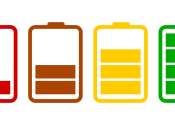Samsung is working on laptop with foldable display
Laptops with folding screens? Never say never when the visionaries at Samsung get excited far beyond words, such as "Signing off, see you in the morning."
Consumer & Gadgets

Laptops with folding screens? Never say never when the visionaries at Samsung get excited far beyond words, such as "Signing off, see you in the morning."
Consumer & Gadgets

Hidden among the announcements during Apple's Monday event was the introduction of the tech giant's latest accessory: a polishing cloth.
Oct 19, 2021
0
11
Energy & Green Tech

Lithium-ion batteries are recognized for their high energy density in everything from mobile phones to laptop computers and electric vehicles, but as the need for grid-scale energy storage and other applications becomes more ...
Jul 17, 2020
0
69
Consumer & Gadgets

European officials on Tuesday agreed the text of a proposed EU law imposing a standard charger for smartphones, tablets and laptops sold in the bloc, in a blow to Apple.
Jun 7, 2022
0
290
Consumer & Gadgets

Google is finally extending the lifespan of older Chromebooks—the low-cost laptops used by school districts across the country—after years of limited software support sent thousands of those devices to the trash after ...
Sep 21, 2023
0
20
Computer Sciences

NIALM (Non-Intrusive Appliance Load Monitoring) can "sense" appliances using electrical power. NIALM is used in homes and small buildings. For this, NIALM can require hundreds of labeled power signal images from each appliance ...
Nov 21, 2022
0
55
Hi Tech & Innovation

(Tech Xplore)—Google-patent news this week is all about its patent application first filed back in 2013 calling for a motorized laptop hinge. That is where you have the luxury of opening and closing your little machine ...
Consumer & Gadgets

Asus has stirred up interest in its gaming display for laptops. Asus fittingly chose Europe's largest consumer tech show for the debut site of its fast laptop gaming display. These are being tagged as gaming machines with ...
Hardware

Intel caused quite a stir over an announcement this month at Computex in Taipei. They announced battery-boosting technology. Longer message made short, Intel claims it can cut display battery use in half with its new tech.
Consumer & Gadgets

Microsoft's recent announcement that it would end support for users of its Windows 7 operating system had stress written all over it. The company advised that important day-to-day tasks such as personal banking and online ...
Feb 4, 2020
1
4
A laptop is a personal computer designed for mobile use small enough to sit on one's lap. A laptop integrates most of the typical components of a desktop computer, including a display, a keyboard, a pointing device (a touchpad, also known as a trackpad, and/or a pointing stick), speakers, and often including a battery, into a single small and light unit. The rechargeable battery (if present) is charged from an AC adapter and typically stores enough energy to run the laptop for two to three hours in its initial state, depending on the configuration and power management of the computer.
Laptops are usually shaped like a large notebook with thicknesses between 0.7–1.5 inches (18–38 mm) and dimensions ranging from 10x8 inches (27x22cm, 13" display) to 15x11 inches (39x28cm, 17" display) and up. Modern laptops weigh 3 to 12 pounds (1.4 to 5.4 kg); older laptops were usually heavier. Most laptops are designed in the flip form factor to protect the screen and the keyboard when closed. Modern tablet laptops have a complex joint between the keyboard housing and the display, permitting the display panel to twist and then lay flat on the keyboard housing. They usually have a touchscreen display and some include handwriting recognition or graphics drawing capability.
Laptops were originally considered to be "a small niche market" and were thought suitable mostly for "specialized field applications" such as "the military, the Internal Revenue Service, accountants and sales representatives". But today, there are already more laptops than desktops in businesses, and laptops are becoming obligatory for student use and more popular for general use. In 2008 more laptops than desktops were sold in the US and it has been predicted that the same milestone will be reached in the worldwide market as soon as late 2009.
This text uses material from Wikipedia, licensed under CC BY-SA